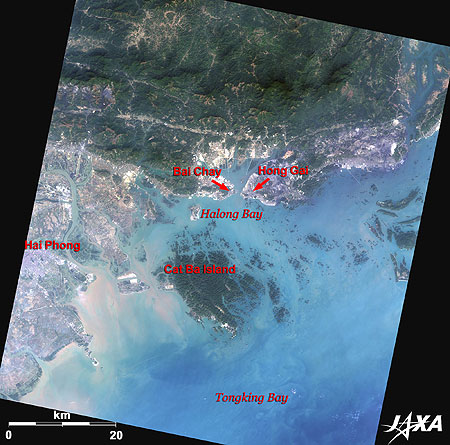

Latest Observation
2010.04.28 Wed
The World Natural Heritage of Vietnam: Halong Bay
Halong Bay, in the northwest of the Gulf of Tonkin in northern Vietnam, is an exceptionally scenic spot. It is the largest tourist resort in Vietnam, located about 150 km east of Hanoi (the capital). Halong Bay, praised by foreign tourists as “Guilin on the Sea,” is also a very special place for the people of Vietnam.
Figure 1 depicts the full image of Halong Bay as observed by ALOS (“Daichi”) in December 2009. The big island in the center of the image, surrounded by small islets, is Cat Ba Island. There are about 2,000 islets in the bay and most of them are uninhabited. This geographical landform is part of a limestone plateau that begins in Guilin, China, to the north, and was submerged for millions of years, which created its unusual landscape. Many uniquely shaped islands and rocks were formed through erosion and local people endearingly gave them names such as “Elephant Islet,” “Fighting Cock Islet,” etc. Since these islets consist of limestone, several of them are hollow, forming enormous caves. Halong Bay was listed as a World Heritage Site by UNESCO for its natural beauties in 1994.
Halong Bay tours start from Bai Chay at the north end of the bay, where swimming beaches, an amusement park, hotels, and restaurants are located along the sea coast. Hong Gai, a fishing village on the opposite coast, connects to Bai Chay by ferry. Hai Phong, visible on the left side of the image, is the second largest city in northern Vietnam and serves as an important city for trade.
caption on
caption off
Fig. 2. Enlarged Image of Halong Bay
Halong Bay (kmz, 4.28 MB, Low Resolution) as seen on Google Earth
Figure 2 presents an enlarged image of Halong Bay. The Halong Bay cruise departs from Bai Chay Port and visits the islets around Cat Ba Island. As seen from the image, untouched nature is reserved in and around the northwest part of the island; however, some white areas surrounding it indicate land development in progress.
Ha Long means “descending (ha) dragon (long).” According to legend, when the Vietnamese were fighting invaders, the gods sent Mother Dragon and her child dragons down to Earth to help defend the land. The dragons sent out from their mouths pearls that turned into thousands of stone islands and islets, emerging from the sea like great walls against the invader’s boats. The Natural Heritage in Vietnam is expected to remain unchanged in the future.
National Parks in Vietnam
Vietnam has 30 national parks and about 100 jungles scattered all over the country. Many rare species of animals and plants inhabit the tropical forest of Vietnam.
Cat Ba Island and its vicinity were designated a national park of Vietnam in 1986. The park area is 15,000 ha and holds a rich ecosystem including 20 species of mammals, 70 species of wild birds, 20 reptiles, and 750 plants.
Environment of Halong Bay
Halong Bay is one of the most popular tourist sites in the world and many cruise ships and boats have been seen there in recent years. Fuel, oil, and discharge water, along with tourist litter, have created a pollution problem in the bay. Nearby northern Vietnam is also the leading coal production area and thus, rapid industrialization with plants built of cement, bricks, and electric power generation has threatened the environment.
The Japan International Cooperation Agency (JICA) has started the “Halong Bay Environment Conservation Project in Viet Nam” and is investigating the bay. The project was started in April 2010 with the aim of protecting the environment of the bay and promoting sustainable tourism development under the theme “Equal Emphasis on Development and Environmental Protection.”
caption on
caption off
When viewing Figure 3 with red glass over the left eye and blue glass over the right eye, you can see an anaglyphic image of the small islands popping out from the sea surface. Note that upward is north in Fig. 1 and 2, whereas the right hand side is north in Fig. 3, a result of the satellite’s flight direction.
Explanation of the Images:

| Satellite: | Advanced Land Observing Satellite (ALOS) (Daichi) |
| Sensor: |
Advanced Visible and Near Infrared Radiometer-2 (AVNIR-2) and Panchromatic Remote-sensing Instrument for Stereo Mapping (PRISM) |
| Date: | 0336 (UTC) on December 5, 2009 (Simultaneous observation of AVNIR-2 and PRISM) |
| Ground resolution: | 10 m (AVNIR-2) and 2.5 m (PRISM) |
| Map Projection: | Universal Transversal Mercator (UTM) |
AVNIR-2 has four observation bands. The composite images (Fig. 1 and 2) are usually produced by assigning red to Band 3 (610 to 690 nm), green to Band 2 (520 to 600 nm), and blue to Band 1 (420 to 500 nm). The resulting images have natural coloring as if seen by the naked eye. Thus, the following colors designate ground objects:
| Dark Green: | Forests |
| Light Bluish-grey: | Urban areas |
| Brown: | Bare ground |
| Blue: | Sea surface |
| White: | Buildings |
PRISM is an optical sensor for observing ground surfaces with visible and near-infrared signals in the 520- to 770-nanometer (one-billionth of a meter) band. The acquired image is monochrome. PRISM has three independent optical systems (telescopes) to acquire images for nadir, forward, and backward views simultaneously.
Figure 3 combines backward (red) and nadir (green and blue) images of PRISM. The left eye sees the backward image, and the right eye sees the nadir image, which means the left side corresponds to the satellite flight direction pointing south.
Largest commercial city in Vietnam – Ho Chi Minh
The “Pearl of the Adriatic”: Old City of Dubrovnik, Republic of Croatia
Search by Year
Search by Categories
Tags
-
#Earthquake
-
#Land
-
#Satellite Data
-
#Aerosol
-
#Public Health
-
#GCOM-C
-
#Sea
-
#Atmosphere
-
#Ice
-
#Today's Earth
-
#Flood
-
#Water Cycle
-
#AW3D
-
#G-Portal
-
#EarthCARE
-
#Volcano
-
#Agriculture
-
#Himawari
-
#GHG
-
#GPM
-
#GOSAT
-
#Simulation
-
#GCOM-W
-
#Drought
-
#Fire
-
#Forest
-
#Cooperation
-
#Precipitation
-
#Typhoon
-
#DPR
-
#NEXRA
-
#ALOS
-
#GSMaP
-
#Climate Change
-
#Carbon Cycle
-
#API
-
#Humanities Sociology
-
#AMSR
-
#Land Use Land Cover
-
#Environmental issues
-
#Quick Report
Related Resources
Related Tags
Latest Observation Related Articles
-
 Latest Observation 2025.10.01 Wed [Quick Report] Hurricane Humberto “Eye” captured by EarthCARE satellite (Hakuryu)
Latest Observation 2025.10.01 Wed [Quick Report] Hurricane Humberto “Eye” captured by EarthCARE satellite (Hakuryu) -
 Latest Observation 2025.02.28 Fri The world’s largest iceberg, A23a, may have run aground on the continental shelf of South Georgia:
Latest Observation 2025.02.28 Fri The world’s largest iceberg, A23a, may have run aground on the continental shelf of South Georgia:
The trajectory of iceberg A23a observed by “GCOM-W”, “ALOS-2” and “ALOS-4” -
 Latest Observation 2024.11.06 Wed [Quick Report] Heavy rainfalls in eastern Spain, as seen by the Global Satellite Mapping of Precipitation (GSMaP)
Latest Observation 2024.11.06 Wed [Quick Report] Heavy rainfalls in eastern Spain, as seen by the Global Satellite Mapping of Precipitation (GSMaP) -
 Latest Observation 2024.10.11 Fri Antarctic Winter Sea Ice Extent Second lowest in Satellite History
Latest Observation 2024.10.11 Fri Antarctic Winter Sea Ice Extent Second lowest in Satellite History























